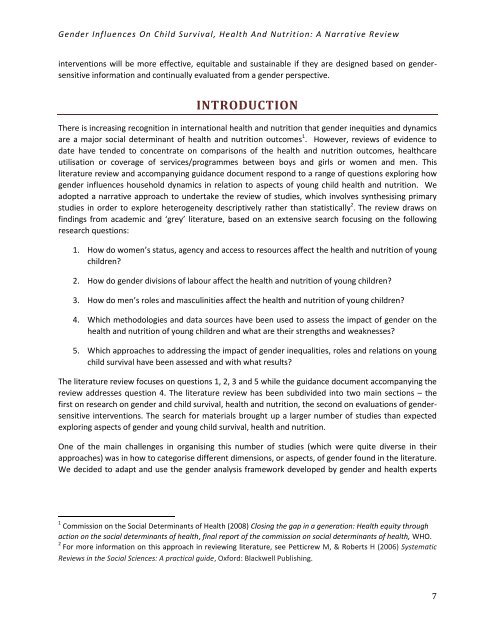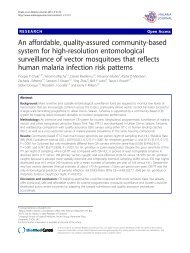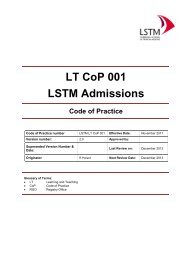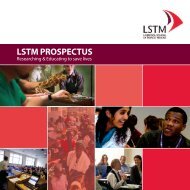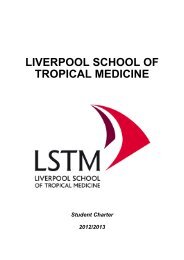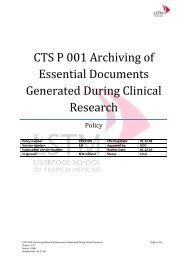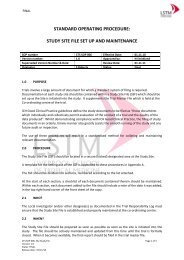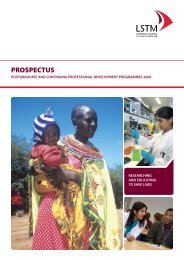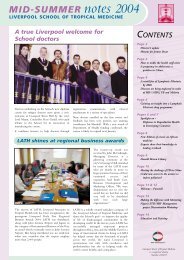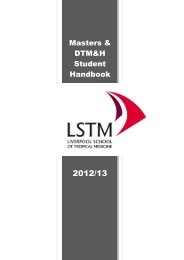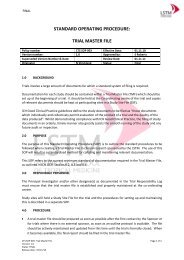Gender influences on child survival, health and nutrition: a ... - Unicef
Gender influences on child survival, health and nutrition: a ... - Unicef
Gender influences on child survival, health and nutrition: a ... - Unicef
Create successful ePaper yourself
Turn your PDF publications into a flip-book with our unique Google optimized e-Paper software.
<str<strong>on</strong>g>Gender</str<strong>on</strong>g> Influences On Child Survival, Health And Nutriti<strong>on</strong>: A Narrative Review<br />
interventi<strong>on</strong>s will be more effective, equitable <strong>and</strong> sustainable if they are designed based <strong>on</strong> gendersensitive<br />
informati<strong>on</strong> <strong>and</strong> c<strong>on</strong>tinually evaluated from a gender perspective.<br />
INTRODUCTION<br />
There is increasing recogniti<strong>on</strong> in internati<strong>on</strong>al <strong>health</strong> <strong>and</strong> nutriti<strong>on</strong> that gender inequities <strong>and</strong> dynamics<br />
are a major social determinant of <strong>health</strong> <strong>and</strong> nutriti<strong>on</strong> outcomes 1 . However, reviews of evidence to<br />
date have tended to c<strong>on</strong>centrate <strong>on</strong> comparis<strong>on</strong>s of the <strong>health</strong> <strong>and</strong> nutriti<strong>on</strong> outcomes, <strong>health</strong>care<br />
utilisati<strong>on</strong> or coverage of services/programmes between boys <strong>and</strong> girls or women <strong>and</strong> men. This<br />
literature review <strong>and</strong> accompanying guidance document resp<strong>on</strong>d to a range of questi<strong>on</strong>s exploring how<br />
gender <str<strong>on</strong>g>influences</str<strong>on</strong>g> household dynamics in relati<strong>on</strong> to aspects of young <strong>child</strong> <strong>health</strong> <strong>and</strong> nutriti<strong>on</strong>. We<br />
adopted a narrative approach to undertake the review of studies, which involves synthesising primary<br />
studies in order to explore heterogeneity descriptively rather than statistically 2 . The review draws <strong>on</strong><br />
findings from academic <strong>and</strong> ‘grey’ literature, based <strong>on</strong> an extensive search focusing <strong>on</strong> the following<br />
research questi<strong>on</strong>s:<br />
1. How do women’s status, agency <strong>and</strong> access to resources affect the <strong>health</strong> <strong>and</strong> nutriti<strong>on</strong> of young<br />
<strong>child</strong>ren?<br />
2. How do gender divisi<strong>on</strong>s of labour affect the <strong>health</strong> <strong>and</strong> nutriti<strong>on</strong> of young <strong>child</strong>ren?<br />
3. How do men’s roles <strong>and</strong> masculinities affect the <strong>health</strong> <strong>and</strong> nutriti<strong>on</strong> of young <strong>child</strong>ren?<br />
4. Which methodologies <strong>and</strong> data sources have been used to assess the impact of gender <strong>on</strong> the<br />
<strong>health</strong> <strong>and</strong> nutriti<strong>on</strong> of young <strong>child</strong>ren <strong>and</strong> what are their strengths <strong>and</strong> weaknesses?<br />
5. Which approaches to addressing the impact of gender inequalities, roles <strong>and</strong> relati<strong>on</strong>s <strong>on</strong> young<br />
<strong>child</strong> <strong>survival</strong> have been assessed <strong>and</strong> with what results?<br />
The literature review focuses <strong>on</strong> questi<strong>on</strong>s 1, 2, 3 <strong>and</strong> 5 while the guidance document accompanying the<br />
review addresses questi<strong>on</strong> 4. The literature review has been subdivided into two main secti<strong>on</strong>s – the<br />
first <strong>on</strong> research <strong>on</strong> gender <strong>and</strong> <strong>child</strong> <strong>survival</strong>, <strong>health</strong> <strong>and</strong> nutriti<strong>on</strong>, the sec<strong>on</strong>d <strong>on</strong> evaluati<strong>on</strong>s of gendersensitive<br />
interventi<strong>on</strong>s. The search for materials brought up a larger number of studies than expected<br />
exploring aspects of gender <strong>and</strong> young <strong>child</strong> <strong>survival</strong>, <strong>health</strong> <strong>and</strong> nutriti<strong>on</strong>.<br />
One of the main challenges in organising this number of studies (which were quite diverse in their<br />
approaches) was in how to categorise different dimensi<strong>on</strong>s, or aspects, of gender found in the literature.<br />
We decided to adapt <strong>and</strong> use the gender analysis framework developed by gender <strong>and</strong> <strong>health</strong> experts<br />
1 Commissi<strong>on</strong> <strong>on</strong> the Social Determinants of Health (2008) Closing the gap in a generati<strong>on</strong>: Health equity through<br />
acti<strong>on</strong> <strong>on</strong> the social determinants of <strong>health</strong>, final report of the commissi<strong>on</strong> <strong>on</strong> social determinants of <strong>health</strong>, WHO.<br />
2 For more informati<strong>on</strong> <strong>on</strong> this approach in reviewing literature, see Petticrew M, & Roberts H (2006) Systematic<br />
Reviews in the Social Sciences: A practical guide, Oxford: Blackwell Publishing.<br />
7


